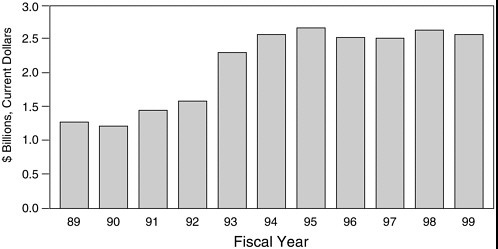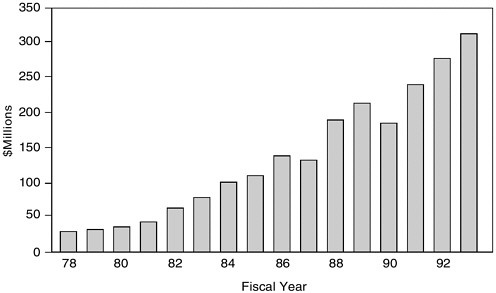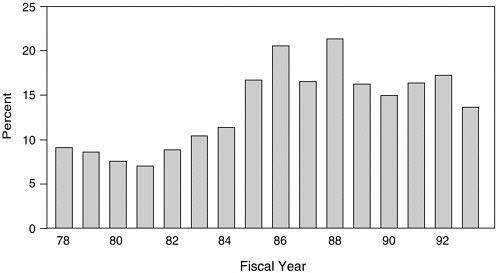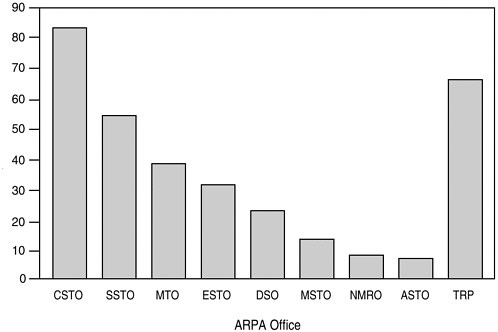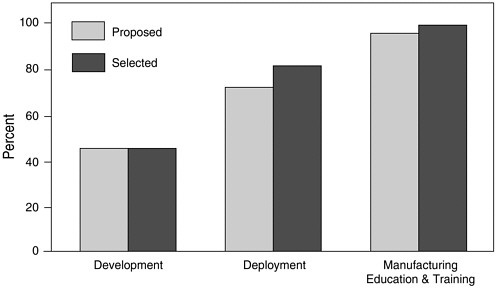Defense Budgets and Academic Research
Duane A. Adams
With the end of the Cold War and the resultant pressures to downsize defense programs, there are real concerns about the impact that Department of Defense (DOD) spending will have on academic research programs. The procurement accounts have been cut in half over the last five years, but the defense leadership has been committed to maintaining a strong science and technology program. The Advanced Research Projects Agency (ARPA) budget has actually been going up, and I will explain what is happening and how.
What I want to do is give a glimpse of what ARPA looks like today in terms of some of our investment strategies. These strategies do change over time; so I will try to point out some of the areas where things are changing. We have a set of technologies that we call core technologies. These are technologies we have invested in for some time; we expect to continue investment in these areas for as long as we can see in the future, and they are the basis for a lot of work that we do in actually developing specific military systems. One of the core technologies is information technology. Included are such programs as high-performance computing, the National Information Infrastructure (NII), research in software engineering, artificial intelligence, and communications technologies.
The second core technology is electronics technology, an area where we have also made investments for some time. It includes a wide range of technologies, from the development of sensors, such as infrared focal plane arrays, to the development of semiconductor manufacturing technologies. The SEMATECH program, which is jointly funded by ARPA and the semiconductor industry, is an example of electronics manufacturing. More re-
cently, research has focused on three new challenges—packaging, flat-panel displays, and MEMS, or micro-electro-mechanical systems. The packaging program is developing manufacturing technologies for multichip modules, or MCM, in which several individual chips are interconnected in a single mechanical package. The flat panel display research is developing a variety of display technologies and their associated manufacturing technologies. The MEMS effort is using semiconductor manufacturing techniques to build arrays of very tiny mechanical moving parts.
And finally, there is the research in materials. We have worked for a long time in developing new materials, such as composites and artificial diamond—and the biggest problem now is being able to manufacture these materials at an affordable cost. It is one thing for the researchers to come up with a new material, it is now equally important to come up with manufacturing technology for that material. An example of a program where we have successfully developed the manufacturing technology is the infrared focal plane array program.
There is a broad area that we are now calling defense infrastructure, and it represents a new focus within ARPA that is being driven primarily by affordability of military systems. With the downsized defense budget, if you cannot design and manufacture a product at an affordable cost, you are really in trouble. The DOD needs to be able to manufacture low-volume semiconductor products at an affordable cost; we do not have the volumes of DRAMs or microprocessors. We need to be able to develop ships without having to create a mock-up of every piece before you build the ship. We should be able to reduce the acquisition costs of aircraft by up to 50 percent. These problems cannot be solved by technology alone; we also need to reform the defense acquisition system, and I will say more about that shortly.
Also, as part of the infrastructure are the projects in education and training, and these are also being driven by cost. If you look at the cost of training troops, which includes coordinating maneuvers involving armor, aircraft, and ships, there has been a major shift toward using distributed interactive simulation. Some of the programs we are working on right now make it possible to integrate what is done in the simulation world with what's being done in the actual test ranges. At some point, you may really not know whether the person you are talking to over the intercom is driving a real tank, or is driving a simulator, or the person who is dropping a bomb is dropping it at Nellis Air Force Base and you're seeing the simulated effects at the National Training Center. It is really very exciting because it brings in research in high-performance computing, communications, and virtual reality. It is a stimulating and challenging area that I believe will have applicability beyond DOD.
Health care is a new investment area for ARPA. We thought long and hard about it and decided to establish a five-year program, drawing exten-
sively on what we have done in information technology and electronics technology, and applying these technologies to some of the problems in health care. In particular, we are looking at the problems of trauma care, where you first want to determine whether someone is injured and the extent of the injury, even though they may not be in your local vicinity; and second, to be able to do something about it. And finally, we are looking at the health information infrastructure. The DOD maintains a large number of hospitals in addition to the care that must be provided on the battlefield, and the cost of medical care for the DOD is eating a significant part of our budget. Here again we are being driven by affordability.
And finally, as you should expect, we have investments in ''military systems. One area of investment is command and control, which draws extensively on our research in information technology and communications technology. You basically want to be able to think and plan inside the enemy's decision cycle, and to communicate your decisions to the forces. Our research in command and control is just as applicable to the civilian sector, if you think of all the things that go on in crisis management. Think of what happened with the recent earthquakes, fires, and hurricanes this country has experienced and the problems of not being able to get information to the people who need it.
A second area is combat vehicles. Aircraft procurement is one of the most costly elements in the defense budget, and ARPA has had a series of programs in aircraft development. We will continue to invest in these programs. We also have a program in simulation-based design for ships; and a new program called Maritech, which is modeled after SEMATECH, is trying to help the ship-building industry.
In our Precision Strike investment area, a major program called War Breaker focuses on detecting and targeting critical mobile targets. It does not help much if you find them two days later from aerial photographs or satellite photographs.
New areas we are exploring include counterproliferation and operations other than war. Even with the dissolution of the Former Soviet Union, we still have a major concern about weapons of mass destruction, whether they be nuclear, chemical, or biological. We have moved from a stable (though threatening) environment to one where there is a great deal of uncertainty from the military view point. Many of our current weapon systems do not help much in some of the new missions such as peacekeeping. The research challenge is to continue to provide our forces with the equipment for the missions they will encounter.
Let me talk about some of the characteristics of ARPA, particularly as they apply to academic research. First, we are a projects agency; it's in the name. And for us, it gives us great flexibility; it means that we can start and stop projects. If a new opportunity comes up, we can move in that
direction. As an agency, we do not have laboratories or infrastructure that must be maintained, and there are no entitlement programs, although sometimes when you look at the way things are added to our budget by Congress, it almost feels like an entitlement program. The flexibility that we have and the fact that we can create projects, change the office structure if we need to, put critical mass onto a problem domain, really lets us do a lot. But we also terminate programs when we have completed what we set out to do. This can be a problem for universities, because the time constraint under which we operate may not be the same as that of universities, particularly if they are supporting graduate students.
We are part of DOD, as you know, and all the decisions we make are driven in part by what it means to the DOD. John Armstrong (in this volume) talked about the difficulty of investing in purely commercial technologies. We understand that very well. Even as we change our name from "DARPA" to "ARPA" and take on a dual-use responsibility, one of the uses is always the military use; if it does not have a military requirement, we should not be doing it. I will discuss later what dual use means for us.
A characteristic for our budget is that we fund everything from basic research (6.1 in the DOD nomenclature) through exploratory development (or 6.2). and on into the advanced development, which is 6.3a. The basic research program that we have is really the smallest part of our budget. We spend less than $100 million a year in basic research; the exploratory development has about $800 million. The rest of it, and the growth of the program, has all been in advanced development, and I will show in a moment what has caused this growth. The boundaries between different funding categories is not rigid, and we have sufficient flexibility to fund a wide range of research.
Let me now talk about some of the very broad trends at ARPA. Information technology is now the key technology at ARPA. Two of our nine offices are devoted to nothing but information technology, and every office in the agency is either a developer or a major user of information technology. So, this has been a change over time.
The second change is the role that manufacturing now plays in the agency. If you add up all the programs that have a manufacturing flavor, it is close to a billion dollars. A few years ago ARPA had an office called the Defense Manufacturing Office. We no longer have a single office called manufacturing, but rather, a number of the offices, probably at least half of them in the agency, are doing some form of manufacturing research. This is being driven largely by questions of affordability.
There are two new program areas at ARPA: health care, which I have already mentioned, and environmental research. In the environmental area, one thrust is in environmentally conscious manufacturing, with the current emphasis being on semiconductor manufacturing. We are beginning a new
program in "green" manufacturing, where the complete life cycle of the product is taken into account, including the recycling or take-back of the product after its useful life. And finally, there is the problem of disposing of various kinds of waste material. ARPA has a supercritical water oxidation program to treat a variety of materials, including chemical warfare agents, propellents, and other DOD hazardous wastes.
Let me now discuss some of the trends that are affecting what we do.
First, let me talk about the "dual use" trend. Historically, about 70 percent of the ARPA budget has been spent on dual-use technology, so the name change from DARPA to ARPA and the greater emphasis on dual-use technology has not resulted in a significant change in the way ARPA operates. For many technologies, such as information technology, the most effective way to insert this technology into DOD systems was to make it available commercially. There have been a couple changes in the way we operate: We make a more conscious effort to look at both the defense and the commercial potential of our investments, and we are becoming more conscious of some of the business decisions that will affect commercialization of a technology or product.
Downsizing has had a major impact on defense acquisition and on the force structure, but it has not resulted in a decrease in the science and technology budget. There has been an indirect effect, though, since the downsizing in defense has made affordability a focus for much of our research.
The next trend, that of congressional earmarking, is a serious problem that has gotten worse over the past few years. Earmarking occurs when the appropriation committees write report language that "earmarks" funds for specific projects or organizations. The problem is actually broader than just earmarking. For FY94 nearly 70 percent of our budget has some form of congressional restrictions—earmarks, fences, or reprogramming restrictions. The Technology Reinvestment Project (TRP) had several earmarks attached to it; the TRP also had legislation requiring that it be competitive. The FY93 TRP selections have all been made, and all of the selections were made on the basis of merit. In some instances earmarked projects competed and won. In other cases earmarked projects are being funded with non-TRP DOD funds.
Another trend is toward more "interagency collaboration." For a long time ARPA and the National Science Foundation (NSF) have had a close working relationship and have done many projects jointly. We have now moved beyond bilateral collaborations and have established several multiagency projects. I will cite three. The Technology Reinvestment Project is headed by ARPA with participation by NSF, the Department of Energy, the National Institute of Standards and Technology, NASA, and the Department of Transportation.
The High Performance Computing and Communications program is a
collaboration among ten agencies; each has money in its own budget, but there are cross-cutting activities that are coordinated by the Office of Management and Budget and the Office of Science and Technology Policy. Another example is the National Information Infrastructure in which there is extensive cooperation across most federal agencies. I personally feel that the cooperation that we see today is as good as I have ever seen it in the federal government across the agencies.
There is a trend toward doing more projects by consortia. The consortia frequently involve both industry and universities. I think it is a positive trend to see universities and industry working together. The TRP program, for example, required that consortia be formed. But it was happening even before the TRP came around, and I think it has been aided by the newly authorized funding methods. In addition to grants and contracts, ARPA is now using new funding vehicles called "agreements" and "other transactions" very extensively. This allows us much greater flexibility in the kind of agreements that we strike between the government and the contractors. For example, we have frequently renegotiated the intellectual property rights to provide a greater incentive to industry to commercialize the results of their research.
Finally, there is defense conversion. I've already mentioned the Technology Reinvestment Project (TRP). For the TRP and other efforts in defense conversion to be successful, they must be accompanied by acquisition reform. For DOD, in particular, as we downsize and as the procurement budget decreases, the corresponding overhead caused by the accounting requirements, military specifications (MILSPECS), extensive documentation, and various things that have driven the cost up have not come down proportionately. So, the DOD's real procurement budget is getting squeezed by more than just the downsizing, and only real acquisition reform will be able to change this trend.
Let me now discuss the ARPA budget. Figure 1 is a plot of the ARPA budget in current dollars; it has not been adjusted for inflation. Notice that starting in FY93 the budget ramps up fairly significantly and then holds constant at about $2.5 billion through fiscal year 1999. I expect it is actually going to go higher.
Figure 2 shows the budget for three fiscal years, 1993, 1994, and 1995. In FY93 the ARPA component of the President's budget was $1.3 billion. We recently tallied up how much money we managed during FY93, and it was over $2.7 billion dollars. And, by the way, that was with no additional people in the agency. We only have about 200 people; I think we are about one-sixth the size of NSF, and our budgets are approximately the same.
Here's what happened: There were some large programs in the Pentagon, one called the air defense initiative, and one called the balance technology initiative, worth combined about $300 million, which were managed
by ARPA. In FY94 they became part of the ARPA budget. When our FY93 budget was submitted last year, Congress added almost a billion dollars to it. More than $500 million was added for ''defense conversion"; it is what became the TRP program. And then there were a number of programs that Congress had been funding on a year-by-year basis: Examples include flat-panel display technology, lithography, electronic packaging, and some research in materials. It is very difficult to run a program if you get money on a year-by-year basis without any out-year budgeting, and so you really have to hedge your bets with a lot of options or you forward fund an entire program.
As part of the President's FY94 budget, the Defense Department included about $325 million for the TRP. A number of the congressional programs were also funded as part of the basic defense budget for ARPA, and the budget grew to about $2.2 billion. The final budget that was appropriated by Congress contained $475 million for defense conversion and a number of other programs added by Congress, raising the total to more than $2.6 billion. A number of our proposed programs were not funded.
For the out-years, from fiscal 1995 to fiscal 1999, ARPA will have more than $600 million a year in the TRP. That is almost a quarter of our budget for this program. We cannot predict what Congress will do when the budget is submitted, but I suspect that the budget will be pushed upward toward the three billion mark.
Figure 3 shows how the universities have fared with ARPA funding over the years. These figures are, again, in current dollars and you can see that there has been an increase. In FY93, $300 million went to universities. It is getting harder to do the accounting because of the TRP program, and I will explain that in just a minute.
Figure 4 shows the university funding as a percent of the total ARPA budget, and you'll notice that it has more or less leveled off at about 17 percent of our total budget. It is down in FY93 because of the TRP. Figure 5 shows what is happening. First, its shows how the funding varies by the various ARPA offices. The Computing Systems Technology Office (CSTO) and the Software and Intelligent Systems Technology Office (SISTO) account for nearly 45 percent of the total university funding. The second point deals with the TRP. On the order of $60 million is going to universities. Part of that is for the manufacturing education and training component of the TRP, and part of it reflects universities as members of a number of TRP consortia. At this time we do not have an adequate way to project the amount of consortia funding that goes to universities or to any particular company.
There is one additional point to make about university participation in the TRP. Figure 6 shows that nearly 40 percent of the development proposals that were submitted contained at least one university participant and

FIGURE 7 Percent university participation in TRP proposals and funded projects, by ARPA category. Source: Advanced Research Projects Agency.
nearly 100 percent of the proposals in manufacturing education and training contained at least one university. If you look at the total number of organizations that participated in the TRP—universities, companies, national labs—you will find that over 10 percent of the development participants and nearly 40 percent of the manufacturing education and training participants were universities. (See Figure 7.)
Let me turn now to some of the opportunities for the university research community. The first is to develop better collaboration with industry. I think it is absolutely essential for both the universities and for industry that we have this collaboration. One of the mechanisms that I see making this happen is the funding mechanisms called agreements and other transactions. This allows us to structure some very flexible arrangements that do not force either the university or the industry to be a subcontractor to the other.
I think the collaboration with industry is beneficial to the universities because it exposes them to some of the real problems that we in defense want to have solved. For industry, I think the earlier they understand what is going on in some of the new technologies, the easier it will be to incorporate these technologies into their projects. In some cases, such as in data storage, the universities are playing a major role in developing the technology; they are almost the development labs for industry in some instances.
The next three opportunities are closely related. The first is the notion of interdisciplinary, or multidisciplinary, research. For many of the most difficult problems that we need to deal with, such as in robotics, manufacturing, or data storage, this collaboration—this interdisciplinary activity—is
absolutely essential, today's tough problems do not map into the traditional disciplines around which most university programs are organized.
The second of the related topics is systems research. Systems are often hard to deal with in a university environment because of their size and complexity. Yet, there are fundamental problems that we do not understand. We do not understand much about how large systems scale, and the systems we build are going to be increasingly software intensive. This is an area in which collaboration with industry may be very appropriate.
Finally, there is the question of applications and the role of scientists or engineers in helping develop some of the applications. Much of the applications research in the high-performance computing program has focused around applications called "grand challenge" problems. These are problems that are very hard, often pushing the edge of our understanding and the edge of our technology.
Besides the grand challenge problems, which I think have extensive university involvement, there are what we are calling the "national challenge" problems. These are problems that have a broad and direct impact on the nation's competitiveness and the well-being of its citizens. These problems include manufacturing, health care, and education, among others. I think it is important to begin to focus the technologies that we are developing on some of these problem domains.
The last topic I would like to address is personnel exchange at ARPA. We do not have any people to send back to universities, but many of our program managers come from universities under the Intergovernmental Personnel Act (IPA). We currently have about 20 IPAs and we can hire another 15. This is an opportunity for researchers from the university community to come and work with the government for a period of two to four years. Two years is the absolute minimum; four years is desirable. If you know of people who are interested in this, send them to see us, or encourage them to take a sabbatical and spend some time working with the government. NSF offers the same opportunity. I think it would be beneficial to the individual; and it would certainly help us manage our programs and keep abreast of the technologies.

